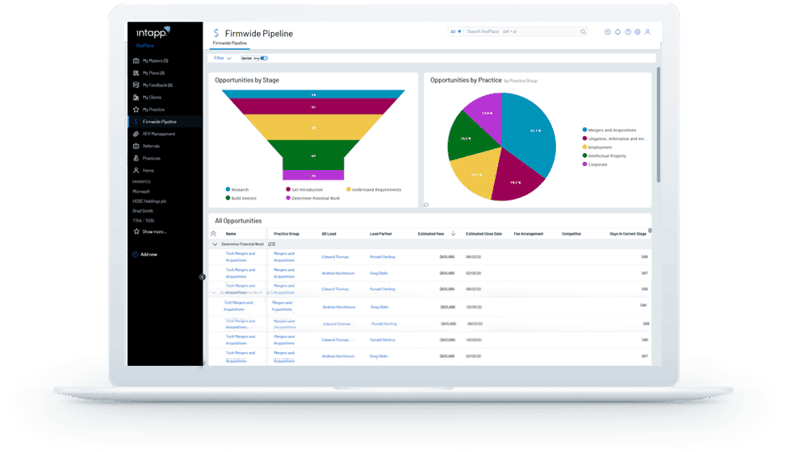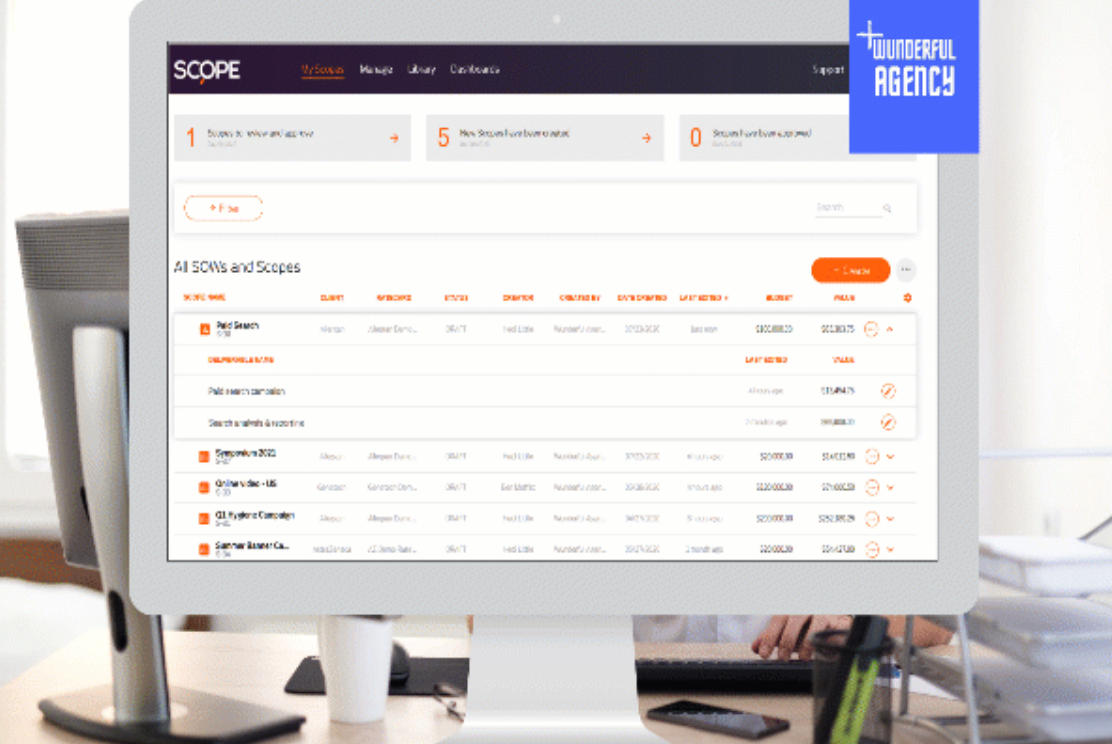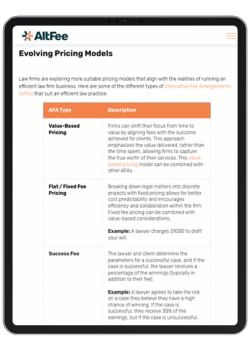- Resources
- A Guide to Value Based Pricing for the Legal Industry
Table of Contents
Change is normal for any industry. As economies, consumer habits, and world events shape our world, we have to be ready to not only face change head-on but embrace it.
The traditional hourly billing model has been difficult for some in the legal industry to let go of in favor of the client-centric value-based pricing model, even though tons of other industries like accounting, management consulting, and more have used it for decades.
But as Bob Dylan puts it, the times they are a-changin'.
Law firms have more incentive than ever before to move to alternative fee arrangements (“AFAs”) or value based pricing methods.
First, it’s easier to build client trust from the beginning when you can confidently present them with pricing that’s attached to value.
Second, AFAs can increase potential revenue with hours worked versus hours billed.
Third, it increases certainty and predictability surrounding legal fees.
Ready to learn more? We’ll elaborate on these reasons and more throughout this article.
Let’s take a closer look at value based pricing and how it’s revolutionizing the legal industry.
What is Value Based Pricing in the Legal Field?
Alternative fee pricing is part of a successful value based pricing strategy — that is, when a law firm uses a mix of collaboration, experience, and research to price out the services they provide based on perceived value instead of a standard hourly rate.
To understand customer value based pricing in the legal industry, we have to talk more about the billable hour. For years, lawyers and legal professionals have been held hostage by timesheets, needing to account for every minute spent working on a client’s case instead of measuring actual results.
Timesheets are to the billable hour like butter is to bread, and both law firms and lawyers everywhere have been working for years to build the perfect sandwich, hiding the inefficiencies and inaccuracies of the billable hour within each layer, and serving it to clients as the best and most reasonable way to pay for legal services.
But is it really?
When we peel back the layers of the billable hour, it’s easy to see the inefficiencies and problems with it:
- Shifts attention away from the quality of work and prioritizes “looking busy”
- Can lead to burnout as lawyers seek a continuous work cycle (lawyers often bill 40 or 50 hours a week when they’re working more like 60-70 hours)
- Causes a lack of certainty and predictability around fees
- Reduces trust between client and lawyer
- Lawyers eventually have to deal with inevitable questions and concerns from clients about billing (bill shock)
If any of these issues sound familiar to you, then your firm is likely a victim of the billable hour.
So how exactly does customer value based pricing fix these issues? Through alternative billing.
First, pricing based on value means that your law firm should be pricing based on perceived value and not on time spent. For example, put yourself in the client’s shoes and imagine you’re pricing out legal services for your divorce. Let’s say you’re trying to decide between two lawyers. One bills by the hour and has great reviews online, and the other also has great reviews but provides a base fee for the legal project, with a clear outline of the fees that are typical for a standard divorce case.
It’s hard to know exactly how long a case like this would take to complete, so you don’t really have any information on what a final cost would look like from the first lawyer. With the second, they provide a guideline of what a typical divorce case costs, plus a set legal firm fee. With the second lawyer, you not only have an idea of what the final price will look like, but you also have a better understanding of each component that goes into the pricing for the service you’re seeking. Even if changes are made as the case progresses, you and your lawyer can easily stay on the same page. Just by changing the pricing structure, it’s clear that the second lawyer provides more perceived value to the client.
In other words, the second lawyer in our example:
- Is establishing a positive pricing relationship with their client from the beginning
- Reducing the likelihood of the client questioning price later on
- Is shifting the focus from time spent on the case to results
- Allowing themselves to have a work-life balance while still providing great service
Instead of putting all the focus on time, pricing based on value encourages legal professionals to collaborate and use their experience to set out pricing, using a method that works for them.
Corporate legal departments (CLDs) are also under increased pressure to move to a more value based pricing system. Basically, the hourly billing model isn’t compatible with a corporation’s desire to have budget certainty with their legal department. After all, they can look at cold hard data and use it as leverage in pricing conversations, encouraging CLDs to find more efficient and effective ways to manage pricing without resorting to giving hourly rate discounts to clients.
At the end of the day, both CLDs and law firms are looking for a way to increase price certainty and reliably predict spending.
Value Based Pricing Methods
Before you can price based on perceived value, you have to get a baseline for what that perceived value is.
Perceived value, in general, considers:
- How much a client is willing to pay for a product or service
- The benefit that product or service provides to the client
- Competitor pricing
For law firms specifically, you’re likely going to price things out based on a few other factors, namely matter type and value, jurisdiction, and risk-sharing. This outlines your value based pricing approach.
Matter type and value assign perceived value to a specific type of work (everything from answering phones to drafting documents) based partly on the considerations we listed above, but also things like the complexity of the work, how skilled you have to be to perform it, how common the work is, and the value that the client assigns to that work.
Jurisdiction may factor into your pricing, such as things like the location of your law firm, market rates, and typical projects that your firm handles.
Risk-sharing helps both the law firm and the client as it encourages the law firm to aim for better results, but also provides better value for the client.
Keeping these points in mind, how should a law firm work to create a value based pricing method? Let’s take a look at some key steps.
1. Determine your organization’s objectivesTo determine your organization’s objectives, you need to come up with a definition for what your organization’s objectives are (e.g. provide affordable legal services, build lasting client relationships, etc.) and align those goals with your pricing structure. This requires collaboration with every stakeholder so a variety of perspectives can influence pricing decisions.
2. Use data to help inform pricingLooking at data sets on different types of work can go a long way in helping to determine value based pricing. Collaboration is key here, as every lawyer in your firm should be able to provide data based on the type of work, whether it was a new or existing client, how much the client paid, what the outcome of their case was, how many hours it took from start to finish, and more.
3. Adjust your pricing model as neededThrough collaboration with legal professionals inside and outside your law firm, you can use gathered data and insights to form a pricing model that works for both lawyers and clients. Of course, there needs to be time spent on planning and implementation, but keep in mind that your base pricing model for each service exists as a guideline (which is why we call them guidelines within the AltFee software) and will change based on lawyer experience, industry trends, level of service offered (some clients may not need every service listed in the guideline) and more. That’s why having a collaborative environment alongside a centralized location for pricing is so important, which is what AltFee’s software provides.
Start Earning More Revenue with Fixed Fees
Break free from hourly pricing and take the fear out of scoping and pricing client projects to start maximizing profitability.
Book A Demo
Value-Based Pricing Strategy vs Billable Hour Model
So what exactly does a value based pricing strategy look like in the real world? Is there a measurable benefit when compared to the billable hourly model?
To answer these questions and more, let’s take a look at an example of how implementing a value based pricing strategy equally benefited a law firm and its retail client.
This legal firm case study from in-Gear Legalytics highlights an issue with efficiency: one of the largest consumer retailers in North America was enlisting the services of 25 different law firms to handle their legal needs across 14 different substantive areas.
One of the law firms saw this as an opportunity to further solidify its relationship with the retailer. If they could take over more of these substantive areas, it would benefit both the law firm and the retail client.
The law firm analyzed the work being done in 14 different legal areas, and while the year-over-year value of the legal services provided consistent value to the client, there were 3 identified areas where the law firm could benefit from investing in technology to streamline work delivery to the client.
To justify investment in this technology and secure a deal at the same time, the law firm created an agreement using an alternative fee structure. Through this agreement and enhanced technology investment, the law firm was able to:
- Improve turnaround time for routine tasks, helping to keep the project on budget
- Improve profitability without the need to have detailed billing discussions with the client (saving time and money for both parties)
- Secure an additional 3 mandates outside the initial AFA, with each mandate expected to earn $100,000 in legal fees for the law firm
Sure, the law firm could have identified inefficiencies and suggested that the retail client invests in technology for the law firm to deliver this work more efficiently and still used an hourly billing model, but then two out of the three benefits would be lost (save time and money on billing discussions and securing additional mandates) if the retail client would have even agreed to an hourly billing model in the first place.
Value-Based Pricing Professional Services
Value based pricing professional services can take on pretty much any form, but most value based pricing methods result in one or more of these fee structures:
- Task or unit-based pricing: This is generally reserved for specific and straightforward tasks, like filing a patent or providing notary public services
- Category based pricing: A fixed fee is assigned to each category of legal work that your firm provides
- Scope based pricing: Similar to some other industries like agency work, legal projects that are comprised of a group of deliverables that can be completed within a set period of time could be charged using a fixed fee.
That being said, the most common non-hourly pricing models that most law firms use include:
- Fixed Fee. As a very simple and straightforward pricing model, the lump sum contract presents a flat fee to the client that covers all work that the lawyer will do. The lawyer is able to provide an accurate estimate of the costs associated with a job in advance based on their experience, research, the scope of the project, and any law firm fees.
- Subscription-Based. For a flat monthly fee, a law firm with a subscription-based payment model offers clients the ability to have ongoing access to legal support depending on the plan they choose. This helps the law firm build and maintain lasting relationships with clients, while at the same time providing an easier and more straightforward billing model when compared to traditional hourly billing.
- Contingency Fee. In cases where monetary compensation might be awarded, the contingency fee outlines in advance how much the lawyer will be paid if they are successful with the case. This is usually outlined in the agreement as a percentage. In other words, the lawyer gets paid when they close a deal or win the case.
Pros and Cons of Value Based Pricing
Like any other pricing model, pricing based on value has its advantages and disadvantages, as outlined in the following table:
|
Advantages of Value Based Pricing |
Disadvantages of Value Based Pricing |
|
Frees you from the constraints of hourly billing |
Requires thoughtful research and collaboration with other legal professionals, which can be difficult for newer firms |
|
Gives clients a better understanding of the total cost of your services |
It takes time — some trial and error is required to get the pricing right |
|
Can increase client satisfaction and loyalty through transparent pricing |
Changes happening to the scope mid-way can contribute to scope creep requiring conversations to price out the additional work |
|
Allows lawyers to become more efficient in their work while at the same time charging what they are worth |
Longer projects may throw off the time spent versus billable hours ratio (e.g. if a project takes 50 hours instead of 40, but you still have to charge the same amount) |
|
Increases the client’s perceived value of your services |
Competitors can affect your pricing strategy, for instance, if they charge below standard market rates |
Pricing Software Considerations
To efficiently and effectively manage your value based pricing model, you’ll likely want to invest in software. While pen and paper and Microsoft Excel spreadsheets are an option, the intricacies of different pricing structures can make it difficult to keep track of what’s happening with your pricing from one moment to the next.
For our analysis, of the below software offerings, we’ll focus on the following:
- Pricing features
- Collaboration opportunities with other legal professionals
- Ease of use
1. AltFee
This is our software, but we’re recommending it for a good reason. The overall aim of AltFee is to improve the legal experience for everyone. That means legal professionals, law firms, and clients, by making it easier to offer accurate and transparent pricing for all legal services. As one of the first legal AFA software offerings, AltFee provides a clean, user-friendly interface that’s easy to navigate and use, even if you’re not the most tech-savvy.
All pricing information for various services is easily accessible through the main dashboard, and the “update template guideline” button makes it easy to make quick changes to pricing templates. The proposed updates are sent to your law firm’s pricing officer(s) for review. The “insights” section allows any of the law firm users to leave comments, feedback, questions, and more for specific project types.
Start Earning More Revenue with Fixed Fees
Break free from hourly pricing and take the fear out of scoping and pricing client projects to start maximizing profitability.
Book A Demo
2. Intapp

Intapp has a series of industry-specific cloud-based software solutions with the aim to provide a more connected firm. From the legal side, Intapp is a practice management tool that helps law firms connect every aspect of their business with the aim of improving operational efficiency and enhancing the overall transparency of the law firm.
To accomplish this, they focus on connecting people, processes, and data together through streamlined dashboards in three categories: marketing and business development, risk and compliance, and operations and finance.
3. Scope

While not specifically designed for law firms, Scope shares the principle of providing a tool to help businesses move away from traditional hourly billing models and into deliverable-based pricing for advertisers and agencies.
The idea is to provide a single source of truth for all projects (or scopes of work) so everyone can see the same information about a project, including progress and work that still needs to be done. This enhances transparency and encourages collaboration, as it’s easy to see where improvements in the workflow can be made and where different teams and departments intersect with a deliverable.
Scope is often compared to Microsoft Excel because a) it aims to get businesses to move away from that tool and b) its look shares some similarities with the program. However, Scope provides essential features that Excel doesn’t, namely with one dedicated platform (no more hunting down spreadsheets saved on various computers), version control and tracking (each change is visible), and language consistency (things like locations, disciplines, and pricing in a project use the same language throughout to reduce confusion).
Conclusion
Law firms of all shapes and sizes are increasingly moving to more modern pricing structures to suit both their clients and the work-life balance of legal professionals. Value based pricing offers cost certainty for clients, helps legal professionals be more confident in their pricing decisions, and makes it much easier to collect payment at the end of a job. Value based pricing software offers law firms a way to structure and control their pricing options so it's consistent, targeted, and can be modified alongside competition and current legal trends.
If you’re ready for a more efficient way to control your law firm’s pricing, then reach out to AltFee for a complete product demo today.
Start Earning More Revenue with Fixed Fees
Break free from hourly pricing and take the fear out of scoping and pricing client projects to start maximizing profitability.
Book A Demo







Newsletter Signup
Subscribe to our newsletter to receive the latest news.



